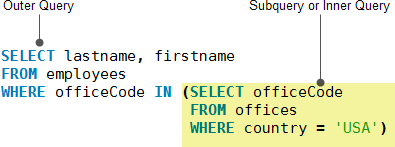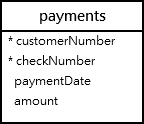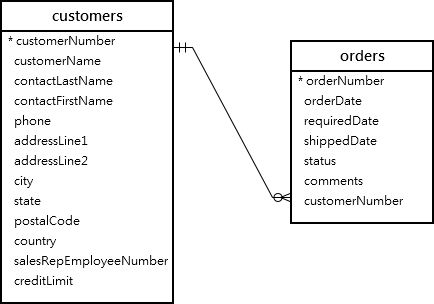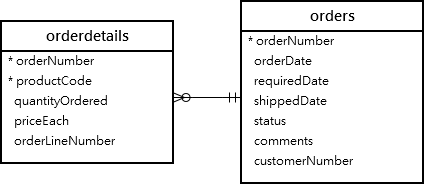Summary: in this tutorial, you will learn how to use the MySQL subquery to write complex queries and understand the correlated subquery concept.
Introduction to the MySQL Subquery
A MySQL subquery is a query nested within another query such as SELECT, INSERT, UPDATE or DELETE. Also, a subquery can be nested within another subquery.
A MySQL subquery is called an inner query whereas the query that contains the subquery is called an outer query. A subquery can be used anywhere that expression is used and must be closed in parentheses.
For example, the following query uses a subquery to return the employees who work in the offices located in the USA.
SELECT lastName, firstName FROM employees WHERE officeCode IN (SELECT officeCode FROM offices WHERE country = 'USA');Code language: SQL (Structured Query Language) (sql)In this example:
- The subquery returns all office codes of the offices located in the USA.
- The outer query selects the last name and first name of employees who work in the offices whose office codes are in the result set returned by the subquery.

When executing the query, MySQL evaluates the subquery first and uses the result of the subquery for the outer query.
Using a MySQL subquery in the WHERE clause
We will use the table payments in the sample database for the demonstration.

MySQL subquery with comparison operators
You can use comparison operators e.g., =, >, < to compare a single value returned by the subquery with the expression in the WHERE clause.
For example, the following query returns the customer who has the highest payment.
SELECT customerNumber, checkNumber, amount FROM payments WHERE amount = (SELECT MAX(amount) FROM payments);Code language: SQL (Structured Query Language) (sql)+----------------+-------------+-----------+ | customerNumber | checkNumber | amount | +----------------+-------------+-----------+ | 141 | JE105477 | 120166.58 | +----------------+-------------+-----------+ 1 row in set (0.00 sec)Code language: JavaScript (javascript)Besides the = operator, you can use other comparison operators such as greater than (>), greater than or equal to (>=) less than(<), and less than or equal to (<=).
For example, you can find customers whose payments are greater than the average payment using a subquery:
SELECT customerNumber, checkNumber, amount FROM payments WHERE amount > (SELECT AVG(amount) FROM payments);Code language: SQL (Structured Query Language) (sql)+----------------+-------------+-----------+ | customerNumber | checkNumber | amount | +----------------+-------------+-----------+ | 112 | HQ55022 | 32641.98 | | 112 | ND748579 | 33347.88 | | 114 | GG31455 | 45864.03 | | 114 | MA765515 | 82261.22 | ...In this example:
- First, get the average payment by using a subquery.
- Then, select the payments that are greater than the average payment returned by the subquery in the outer query.
MySQL subquery with IN and NOT IN operators
If a subquery returns more than one value, you can use other operators such as IN or NOT IN operator in the WHERE clause.
See the following customers and orders tables:

For example, you can use a subquery with NOT IN operator to find the customers who have not placed any orders as follows:
SELECT customerName FROM customers WHERE customerNumber NOT IN (SELECT DISTINCT customerNumber FROM orders);Code language: SQL (Structured Query Language) (sql)+--------------------------------+ | customerName | +--------------------------------+ | Havel & Zbyszek Co | | American Souvenirs Inc | | Porto Imports Co. | | Asian Shopping Network, Co | ...MySQL subquery in the FROM clause
When you use a subquery in the FROM clause, the result set returned from a subquery is used as a temporary table. This table is referred to as a derived table or materialized subquery.
The following subquery finds the maximum, minimum, and average number of items in sale orders:
SELECT MAX(items), MIN(items), FLOOR(AVG(items)) FROM (SELECT orderNumber, COUNT(orderNumber) AS items FROM orderdetails GROUP BY orderNumber) AS lineitems;Code language: SQL (Structured Query Language) (sql)+------------+------------+-------------------+ | MAX(items) | MIN(items) | FLOOR(AVG(items)) | +------------+------------+-------------------+ | 18 | 1 | 9 | +------------+------------+-------------------+ 1 row in set (0.01 sec)Code language: JavaScript (javascript)Note that the FLOOR() is used to remove decimal places from the average values of items.
MySQL correlated subquery
In the previous examples, you notice that a subquery is independent. It means that you can execute the subquery as a standalone query, for example:
SELECT orderNumber, COUNT(orderNumber) AS items FROM orderdetails GROUP BY orderNumber;Code language: SQL (Structured Query Language) (sql)Unlike a standalone subquery, a correlated subquery is a subquery that uses the data from the outer query. In other words, a correlated subquery depends on the outer query. A correlated subquery is evaluated once for each row in the outer query.
See the following products table from the sample database:
The following example uses a correlated subquery to select products whose buy prices are greater than the average buy price of all products in each product line.
SELECT productname, buyprice FROM products p1 WHERE buyprice > (SELECT AVG(buyprice) FROM products WHERE productline = p1.productline);Code language: SQL (Structured Query Language) (sql)+-----------------------------------------+----------+ | productname | buyprice | +-----------------------------------------+----------+ | 1952 Alpine Renault 1300 | 98.58 | | 1996 Moto Guzzi 1100i | 68.99 | | 2003 Harley-Davidson Eagle Drag Bike | 91.02 | | 1972 Alfa Romeo GTA | 85.68 | | 1962 LanciaA Delta 16V | 103.42 | | 1968 Ford Mustang | 95.34 | ..In this example, both the outer query and correlated subquery reference the same products table. Therefore, we need to use a table alias p1 for the products table in the outer query.
Unlike a regular subquery, you cannot execute a correlated subquery independently like this. If you do so, MySQL doesn’t know the p1 table and will issue an error.
SELECT AVG(buyprice) FROM products WHERE productline = p1.productline;For each row in the products (or p1) table, the correlated subquery needs to execute once to get the average buy price of all products in the productline of that row.
If the buy price of the current row is greater than the average buy price returned by the correlated subquery, the query includes the row in the result set.
MySQL subquery with EXISTS and NOT EXISTS
When a subquery is used with the EXISTS or NOT EXISTS operator, a subquery returns a Boolean value of TRUE or FALSE. The following query illustrates a subquery used with the EXISTS operator:
SELECT * FROM table_name WHERE EXISTS( subquery );Code language: SQL (Structured Query Language) (sql)In the query above, if the subquery returns any rows, EXISTS subquery returns TRUE, otherwise, it returns FALSE.
The EXISTS and NOT EXISTS are often used in the correlated subqueries.
Let’s take a look at the orders and orderdetails tables from the sample database:

The following query finds sales orders whose total values are greater than 60K.
SELECT orderNumber, SUM(priceEach * quantityOrdered) total FROM orderdetails INNER JOIN orders USING (orderNumber) GROUP BY orderNumber HAVING SUM(priceEach * quantityOrdered) > 60000;Code language: SQL (Structured Query Language) (sql)Output:
+-------------+----------+ | orderNumber | total | +-------------+----------+ | 10165 | 67392.85 | | 10310 | 61234.67 | | 10287 | 61402.00 | +-------------+----------+ 3 rows in set (0.01 sec)Code language: JavaScript (javascript)It returns 3 rows, meaning that there are three sales orders whose total values are greater than 60K.
You can use the query above as a correlated subquery to find customers who placed at least one sales order with a total value greater than 60K by using the EXISTS operator:
SELECT customerNumber, customerName FROM customers WHERE EXISTS( SELECT orderNumber, SUM(priceEach * quantityOrdered) FROM orderdetails INNER JOIN orders USING (orderNumber) WHERE customerNumber = customers.customerNumber GROUP BY orderNumber HAVING SUM(priceEach * quantityOrdered) > 60000);Code language: SQL (Structured Query Language) (sql)Output:
+----------------+--------------------------+ | customerNumber | customerName | +----------------+--------------------------+ | 148 | Dragon Souveniers, Ltd. | | 259 | Toms Spezialitäten, Ltd | | 298 | Vida Sport, Ltd | +----------------+--------------------------+ 3 rows in set (0.01 sec)Code language: JavaScript (javascript)Summary
- A subquery is a query nested within another query (or outer query).
- A correlated subquery depends on the outer query.